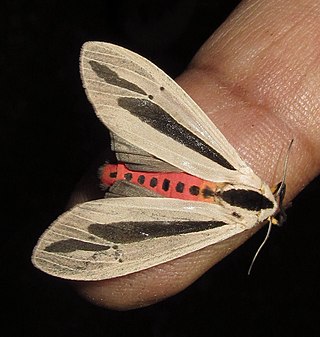
Arctia is a genus of tiger moths in the family Erebidae. Therein, it belongs to the subtribe Arctiina in the tribe Arctiini in the subfamily Arctiinae. Species are well distributed throughout North America, Palearctic, India, and Sri Lanka.

Creatonotos is a genus of tiger moths in the family Erebidae. The moths in the genus are found in the Afrotropics, South and East Asia, Sundaland and Australia.
Lithosarctia is a genus of tiger moths in the family Erebidae. The genus was erected by Franz Daniel in 1954. The moths in the genus are from western China and Himalayas.
Maurica is a genus of moths in the family Erebidae from north-western Africa.

Nebrarctia is a genus of moths in the family Erebidae from the Near East, Central Asia and Himalayas. The genus was erected by Otto Staudinger in 1891.

Paidia is a genus of moths in the family Erebidae erected by Jacob Hübner in 1819.

Watsonarctia is a monotypic moth genus in the subfamily Arctiinae erected by Josef J. de Freina and Thomas Joseph Witt in 1984. Its only species, Watsonarctia deserta, the chaste pellicle, was first described by Max Bartel in 1902. It is found in central and south-eastern Europe, southern Russia, southern Siberia east to Lake Baikal; also in Asia Minor, Armenia, Azerbaijan, northern Iran, Kazakhstan, Kyrghyzstan and Xinjiang in China.

Heterogynis is a genus of moths of the Heterogynidae family.

The Museum Witt Munich (MWM) is a department of the Bavarian State Collection of Zoology. It is located in Munich, Germany, and has the world's leading collection of moths.
Cabomina is a genus of moths in the family Sesiidae.
Chelis kozlovi is a tiger moth species in the family Erebidae. It is found in northeastern Tibet. The species was first described by Vladimir Viktorovich Dubatolov in 2008. The species name is after Pyotr Kozlov, a disciple of Nikolay Przhevalsky, who first collected the holotype in 1900.

Synanthedon stomoxiformis is a moth of the family Sesiidae. It is found in most of Europe and the Middle East.
Creatonotos omanirana is a moth of the family Erebidae. It was described by Josef J. de Freina in 2007. It is found in Oman, the United Arab Emirates and Iran.
Nebrarctia hunza is a moth of the family Erebidae. It was described by Josef J. de Freina in 1997. It is found in northern Pakistan.
Orontobia mooseri is a moth of the family Erebidae. It was described by Josef J. de Freina in 1997. It is found in Tibet.
Orontobia secreta is a moth of the family Erebidae. It was described by Max Wilhelm Karl Draudt in 1931. It is found in China and Tibet.
Orontobia taglangla is a moth of the family Erebidae. It was described by Josef J. de Freina in 1997. It is found in western Tibet.
Paidia moabitica is a moth of the family Erebidae. It was described by Josef J. de Freina in 2004. It is found in Jordan.
Setina cantabrica is a moth in the family Erebidae. It was described by Josef J. de Freina and Thomas Joseph Witt in 1985. It is found in Spain.
Semagystia cuhensis is a moth in the family Cossidae. It was described by Josef J. de Freina in 1994. It is found in Turkey and Transcaucasia.







